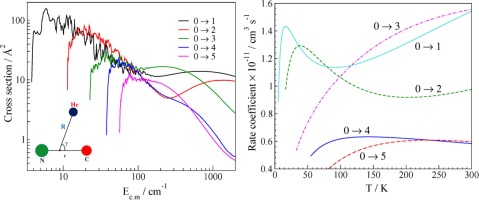Computational and Theoretical Chemistry ( IF 3.0 ) Pub Date : 2020-02-15 , DOI: 10.1016/j.comptc.2020.112748 Bhargava Anusuri

|
Modeling the physical conditions of interstellar medium requires knowledge of accurate rate coefficients for collisional excitation of molecules by the abundant chemical species like He and H2. The present paper aims to study transitions in the low rotational levels in the ground vibrational state of CN+(X 1Σ+) by collisions with helium atoms. We computed ab initio two-dimensional (rigid-rotor) potential energy surface for the He-CN+ van der Waals collision complex using multi-reference configuration interaction method employing augmented correlation consistent polarized valence quadruple-ζ basis set. The bound-states of the van der Waals complex are obtained by coupled channel approach. The state-to-state rotational excitation cross sections are computed by exact close-coupling quantum mechanical formalism up to center of mass collision energy of 2000 cm−1. The corresponding rate coefficients are obtained up to 300 K temperature.
中文翻译:

氰离子,CN的转动激发+(X 1 Σ +何冲突)
对星际介质的物理条件进行建模需要了解准确的速率系数,以便利用He和H 2等丰富的化学物种对分子进行碰撞激发。本文件的目的,研究在低转动能级跃迁在CN的地面振动状态+(X 1 Σ +通过与氦原子的碰撞)。我们计算了He-CN +的从头算起的二维(刚性转子)势能面范德华碰撞复合物采用多参考构型相互作用方法,采用增强相关一致一致极化价四元组-z基集。范德华复合体的束缚态是通过耦合通道方法获得的。通过精确的紧耦合量子力学形式来计算状态到状态的旋转激励横截面,直到质量碰撞能量中心为2000 cm -1为止。在最高300 K的温度下可获得相应的速率系数。











































 京公网安备 11010802027423号
京公网安备 11010802027423号